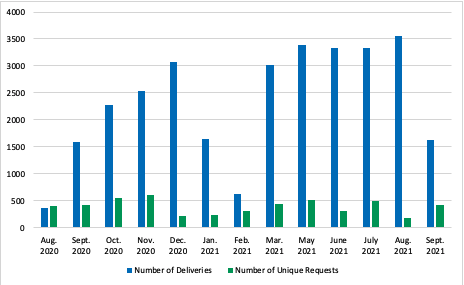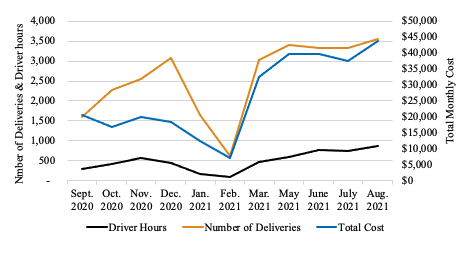The COVID-19 pandemic prompted transit agencies across the country to quickly modify service, protect the health of passengers and drivers, and yet continue to provide critical transportation services. One of the more unique pandemic responses occurred in Los Angeles, where LA Metro and Via launched a food delivery service using drivers from its mobility on demand (MOD) pilot. This pilot originally offered rides to and from select rail stations, but began allowing point-to-point service in March 2020 as well as food delivery shortly after.
LA Metro’s food delivery service was a product of a partnership with an independent public agency, First 5 LA, that had invested in 14 vulnerable communities in Los Angeles County through its Best Start initiative. When First 5 LA’s local grantees launched food distribution efforts at the beginning of the pandemic, the agency asked LA Metro whether it had the ability to assist with food delivery within the Best Start Communities. LA Metro partnered with the Best Start initiative to redirect excess driver capacity from the MOD rideshare pilot to provide free food delivery to residents in need within these 14 communities. Deliveries were pre-scheduled and capped at 75o trips per week.
These service changes in light of the pandemic reflected a significant shift in the pilot’s intended purpose and served as a unique opportunity to assess the ability for a transit agency to pivot to providing essential services beyond passenger travel. This article summarizes key findings on the food delivery service offered by the Los Angeles MOD pilot from August 2020 to August 2021, using data collected by the MOD research team.
Key Findings
During the evaluation period, drivers completed over 30,000 grocery deliveries to 1,748 people in Best Start communities (Figure 1). (Note: Food deliveries dipped in January and February 2021 due to a transition between contracts that paused food delivery service for approximately four weeks) Most recipients of Metro’s food delivery program were infrequent users – about a third of users received just one delivery during the pilot period, and half used the program less than once per month. Around 20 percent of users used the service more than once a month. Given the pilot was confined to 14 Best Start communities, deliveries were concentrated within these service areas, particularly areas west of Downtown Los Angeles.
Figure 1: Number of Unique Food Delivery Requests and Deliveries by Month

Recipients of the food delivery service reported high levels of satisfaction with the program, including the ease of requesting deliveries, the quality of the food received, feelings of safety, and convenience. Recipients of the food delivery service were generally individuals who had long travel times – 30 minutes on average – to their grocery store before participating in the pilot. More than half of the participants usually drove themselves or were driven by a friend to the grocery store, while around 40 percent typically walked or took transit. A large majority of food delivery recipients – nearly 80 percent – normally paid for their groceries with cash or EBT card.
Deliveries, and therefore costs, fluctuated significantly throughout the pilot. The program averaged 2,338 deliveries per month at an average monthly cost of over $26,000. Monthly costs, however, ranged from as low as $7,310 to as high as $43,820. The average cost per delivery was $10.13, ranging from $7.62 to $13.04 (see Figure 2). The average cost per delivery was significantly lower than the average cost of over $20 per trip for the point-to-point passenger trip service in the same the pilot.
Figure 2: Food Deliveries, Driver Hours, and Monthly Costs over Time

Lessons Learned
The food delivery service operated by Via through its partnership with LA Metro represented a unique expansion of the MOD pilot’s mission from providing transportation to also providing another essential service to at-need residents during COVID-19. The grocery delivery service was also significantly less expensive – nearly $10 per trip lower, on average – than the point-to-point service. While the MOD pilot’s point-to-point rideshare service appeared to have provided a large share of its trips to a small share of users, data from the grocery delivery service suggests the service was frequently used by a wider set of customers.
Survey and program data suggest the delivery service made it much easier, safer, and convenient for its users to get groceries. Given the average travel time reported by users, the pilot likely saved each individual user at least an hour of round-trip travel to a grocery store. The program’s service areas also targeted communities with greater food insecurity. With lower income communities more likely to develop serious illness if infected with COVID-19 given higher instance of pre-existing conditions, the pilot likely helped recipients limit their exposure to the virus through grocery shopping and thus reduce their risk of developing severe health complications.
While there is not sufficient data to fully measure the benefits and costs to the agency, the food delivery service was overall a creative, situational response to the COVID-19 pandemic that allowed LA Metro to utilize an existing service to provide another essential service to at-need residents. LA Metro partnership with the First 5 LA initiative allowed the pilot to reach communities where residents have the most barriers to accessing food (both through travel times and income).
The food delivery program was a relatively low-cost, high value service that not only provided significant benefits to its recipients, but also replaced at least two lengthy one-way trips for each delivery. Regardless of those benefits, this goes beyond traditional transit goals and objectives by moving goods instead of people and directly replacing trips that might have been completed on the existing services. Individual agencies would need to determine whether they should be the ones leading and funding such an initiative. But during unique circumstances like the one facing the MOD pilot in Los Angeles, there are clearly powerful and creative opportunities to leverage existing transit resources to provide additional help to communities in need.





